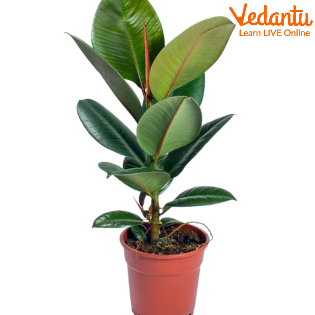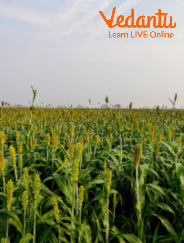Must-Know Crop and Plant Terms, Definitions, and Real-Life Applications
We all have seen fields of wheat or rice and the plants of fruits and vegetables. Crops and plants are both grown for the food requirement of humans and animals. They both provide us with various essential products. However, do you know the difference between a crop and a plant? How can you differentiate a crop from a plant? All crops can be considered as plants but all plants cannot be considered as crops.
In this article, we are going to learn about crops, plants, the difference between crop and plant, examples of crops and plants, the concept of agriculture and horticulture and their difference, food crops and difference between agriculture and farming.
What is a Plant?
The photosynthetic eukaryotes, which belong to the kingdom plantae, are called plants. Plants prepare their food from sunlight and water by chloroplasts and are mostly multicellular organisms.

Plant
The examples of plants include:
Bamboo
Cactus
Orchids
Snake plants
Tomato, etc.
What is a Crop?
The plants which are grown and harvested commercially for fulfilling the consumption needs of humans are termed as crops.

Crop
The crop examples include:
Wheat
Rice
Soyabean
Millets
Maize
Types of Crops
Crops can be classified into six categories:
Food Crops
Feed Crops
Fibre Crops
Oil Crops
Ornamental Crops
Industrial Crops
Let’s define food crops. Crops that are grown for human consumption like wheat, rice, barley, etc. are termed as food crops. On the basis of the month, food crops are divided into 3 classes – Kharif crop, rabi crop and zaid crop.
Difference Between Crop and Plant
The difference between crops and plants on the basis of their definition, existence and domestication are as follows:
Difference Between Crop and Plant
All crops are plants, however, not all plants are crops. Plants are found naturally within the environment, whereas crops are grown economically. The terms scientific agriculture and horticulture are associated with crops and plants in the following manner:
Agronomy is the application of plant and soil science to crop production. Horticulture is the science and art of cultivating fruits, vegetables, flowers, and decorative plants.
What is Agriculture?
Cultivation is crucial to the survival of human beings. We have relied on cultivation for food and livelihood since the stone age. Agriculture is a variety of cultivation that's used to manufacture food and therefore the products associated with it. Agriculture includes numerous activities in its ambit, like farming, irrigation, cattle farming, sustainable agriculture, animal husbandry, etc.
The process of cultivating soil by growing crops and livestock is termed as agriculture. It doesn't mean growing crops only; however, the raising of animals and preparation of animal products is additionally considered as agriculture.
What is Horticulture?
According to the horticulture definition, “The science and art of growing, producing, marketing, and utilising high-value, intensively grown food, and decorative plants in a sustainable manner is termed as Horticulture”.
Horticulture too is basically cultivation, but not of identical degree as agriculture. Horticulture is more inclined towards the domestic side of cultivation. An activity like growing plants, vegetables, fruits, etc. in a domestic environment is horticulture. Horticulture may additionally entail gardening, growing a nursery of plants, growing roots and shoots, etc. Since horticulture is practised on a small scale, it's comparably more cost-effective than agriculture.
Difference Between Agriculture and Horticulture
Comparison between agriculture and horticulture is shown in the following table:
Agriculture and Farming Difference
Agriculture is characterised as field development; cultivating and farming are two vital components of agribusiness. Agriculture incorporates a large scope of exercises, including creation, examination, and advancement, whereas farming is the most typical approach of completing rural activities.
Farming may be a more individual effort on including a plot of land with structures on it (for example, fencing, water offices, then on) that is used to cultivate crops and additionally raise animals for human use.
Important Question
Q1. What are the three types of crops?
Ans. The types of crops are:
Kharif Crop: The word “Kharif” is Arabic used for autumn since the season coincides with the start of autumn or winter. As cultivation of these crops happens within the monsoon season, another name for Kharif crop is monsoon crop.
Rabi Crop: Rabi crops are called winter crops. They're full-grown in October or November.
Zaid Crop: Vital crops produced during 'zaid' are watermelon, muskmelon, cucumber, vegetables and fodder crops.
Conclusion
The only living species that may manufacture their own food are plants, and this is often primarily because of the presence of specialised structures within the plant cell. The plants that are full-grown and harvested commercially for fulfilling the consumption needs of humans are termed as crops. The method of cultivating soil by growing crops and livestock is termed as agriculture. Agriculture and horticulture are associated with plants and crops and have similarities as well as some differences also.


FAQs on Crop and Plant: Essential Concepts for Students
1. What is the main difference between a regular plant and a crop?
The key difference lies in purpose and scale. While all crops are plants, not all plants are crops. A plant becomes a crop when it is intentionally grown by humans in large quantities, usually for food or to sell. For example, a single mango tree in a backyard is just a plant, but a field with hundreds of mango trees grown for sale is a mango crop.
2. What are the basic parts of a plant?
A plant is typically divided into two main systems:
- The Shoot System: This is the part you usually see above the ground. It includes the stem, leaves, flowers, and fruits. It is responsible for making food through photosynthesis.
- The Root System: This is the part that grows underground. It anchors the plant in the soil and absorbs water and essential nutrients for the plant's survival.
3. Why do farmers grow different types of crops in different seasons?
Farmers grow different crops in different seasons because each crop has specific needs for sunlight, water, and temperature to grow well. For example:
- Kharif crops (like rice and maize) are sown in the rainy season because they need a lot of water.
- Rabi crops (like wheat and gram) are grown in the winter because they thrive in cooler, drier conditions.
4. What are some examples of different crops grown in India?
Crops in India are broadly classified based on the season they are grown in. Common examples include:
- Kharif Crops (Monsoon): Paddy (rice), maize, soybean, and cotton.
- Rabi Crops (Winter): Wheat, gram, pea, and mustard.
- Zaid Crops (Summer): Watermelon, muskmelon, and cucumber.
5. What is harvesting in agriculture?
Harvesting is the important agricultural task of cutting and gathering mature crops from the fields. This process is done when the crop is ripe, and it marks the end of the growing cycle. Harvesting can be done either manually using tools like a sickle or mechanically using large machines called harvesters.
6. Besides food, what are other important uses of crop plants?
Crop plants are incredibly versatile and are grown for many purposes beyond just food. Some other major uses include:
- Fibres: Plants like cotton and jute are grown to make clothes, ropes, and bags.
- Oils: Crops such as sunflower, mustard, and groundnut are grown to extract cooking oil.
- Medicines: Plants like neem and tulsi have medicinal properties.
- Sugar: Sugarcane is a major crop grown to produce sugar and jaggery.
7. What makes soil so important for growing healthy crops?
Soil is crucial for growing crops because it provides three essential things for the plant. First, it acts as an anchor, holding the roots firmly in place. Second, it is a reservoir of water and nutrients, which the roots absorb to help the plant grow. Finally, it provides air for the roots to breathe. Without healthy soil, crops cannot get the support and nourishment they need.










